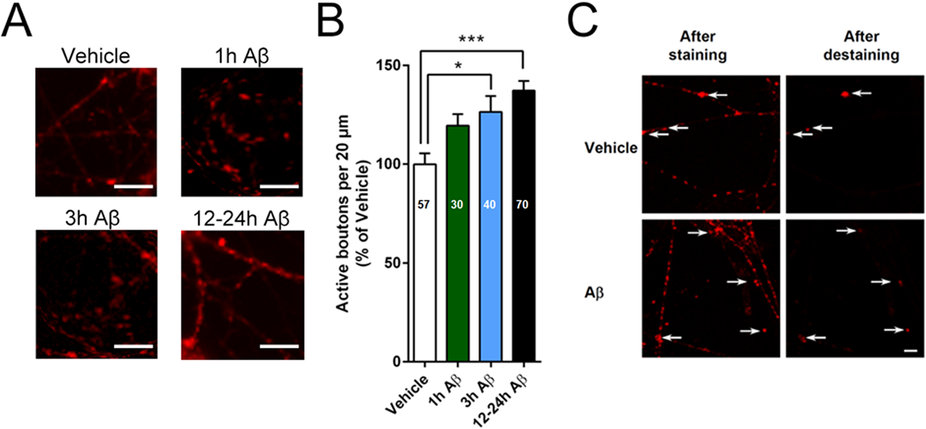Columbia University
Irving Medical Center
Neurological Institute
710 West 168th Street, 3rd floor
(212) 305-1818
TaubCONNECT Research Perspectives:
September 2016
» #2 Evidence that COMT Genotype and Proline Interact on Negative-Symptom Outcomes in Schizophrenia and Bipolar Disorder

Ottavio Arancio, MD, PhD
Increase in the levels of Aβ peptide in the brain is viewed as a relevant early mechanism in Alzheimer's disease (AD) etiopathogenesis. However, Aβ-targeted therapies have, thus far, failed to enter the market. This is likely due to the fact that it is not clear why the homeostasis of the peptide, which is normally present in the brain in very low amounts, breaks and its levels become elevated. Starting with the observation that the peptide is cleared by an enzyme, neprilysin, which declines during aging and in the brains of AD patients—an event that could lead to a prolonged availability of low Aβ concentrations at the synapse—the laboratory of Dr. Ottavio Arancio investigated whether prolonged exposure to Aβ in low physiological levels might impair synaptic plasticity and memory.
Published this month in Scientific Reports, results from Dr. Arancio and his collaborators suggest that short and prolonged exposures to low Aβ concentrations that mimic endogenous levels in the healthy brain can alter synaptic properties in distinct ways. In particular, their findings demonstrate that while short exposures to low concentrations of Aβ facilitate synaptic potentiation, both in hippocampal cultures and slices, and enhance memory in mice, longer exposures (lasting for several hours) lead to reduction of synaptic plasticity and memory. These effects were associated with a series of changes in the distribution of synaptic proteins at the connection between brain cells, leading to an increase in transmitter release from the synapse. In addition, Koppensteiner et al. found that the detrimental effects of long exposures to low Aβ concentrations were caused by actin polymerization.
 (A) Example of FM 1–43 labeled boutons after treatment with vehicle or 200 pM Aβ42 for 1, 3 and 12–24 hours, scale bar = 10 μm. (B) The number of active presynaptic release sites was significantly increased in cultures treated with 200 pM Aβ42 for 3 and 12–24 hours compared with vehicle-treated cells. *P < 0.05, ***P < 0.001, one-way ANOVA with Bonferroni post hoc test. (C) Examples of activity-dependent FM 1–43 staining and destaining in vehicle and Aβ treated hippocampal cultures. Scale bar, 5 μm.
|
The present findings give a new dimension to the concept of synaptic dysfunction in Alzheimer's disease. They provide a model for initiation of synaptic dysfunction, whereby exposure to physiologic levels of Aβ for a prolonged period of time causes microstructural changes at the synapse, resulting in increased transmitter release, failure of synaptic plasticity, and memory loss. Accordingly, restricting the release of glutamate during early phases of the disease can be envisioned to delay the course of the pathology. Moreover, since the results point towards excitotoxicity due to Aβ acting via a p38MAPK-dependent signaling cascade as an early, pathogenetic mechanism in the development of AD, use of p38MAPK inhibitors might be an effective therapy against the disease. Most importantly, these studies will inspire future investigations aimed at defining the molecular events responsible for changes in the homeostasis of Aβ at the synapse, at the beginning of the disease, with the synaptic effects found by the Arancio lab serving as a model for such studies.
Ottavio Arancio, MD, PhD
Professor of Pathology and Cell Biology (in the Taub Institute)
oa1@cumc.columbia.edu

Catherine Clelland, PhD
Negative symptoms are among the most persistent and debilitating symptoms of psychiatric illnesses such as schizophrenia, and include social withdrawal and emotional unresponsiveness, lack of motivation, and diminished speech and movement. While antipsychotic medications can effectively treat the positive symptoms of schizophrenia, such as delusions and hallucinations, there are no current medications that adequately address negative symptoms. Unfortunately, patients with negative symptoms are often unable to maintain social relationships or find and maintain employment, and as such, negative symptoms contribute significantly to the huge personal and economic costs of severe psychiatric illness.
Proline is a precursor of the neurotransmitter glutamate, and likely also functions as a central nervous system (CNS) neurotransmission modulator: When proline levels are significantly elevated in the CNS, which closely reflects blood levels, the resultant enhancement of glutamatergic and dopaminergic signaling can be neurotoxic. We and others have shown that elevated plasma proline is associated with schizophrenia-spectrum disorders.
In our new study, published in the journal Translational Psychiatry and featured on CUMC Newsroom, we set out to explore whether proline was specifically related to psychiatric symptoms including negative symptoms, and moreover, if this relationship was impacted by a functional variant of the catechol-O-methyltransferase (COMT) gene. COMT encodes an enzyme that in the brain deactivates catecholamines, including dopamine. The functional Val158Met gene variant alters COMT enzyme activity such that people with two copies of the valine (Val) allele have 40% greater prefrontal enzyme activity, and resultant lower dopamine levels, than subjects with the methionine (Met) variant.
 Figure 1. The Interaction between Proline and COMT Genotype on Negative Symptoms in
Schizophrenia. There is a significant interaction between proline and COMT Val158Met genotype on total Schedule for Assessment of Negative Symptoms (SANS) score (p<0.001). The graph shows this relationship plotted for patients with the Met/Met (n=21, red diamonds), Val/Met (n=32, blue triangles) and Val/Val (n=42, green squares) genotypes. Lines represent the predicted values from the regression model for each genotype, with 95% confidence intervals shown. In both Met/Met and Val/Met patients, high proline levels are associated with high SANS scores. Conversely there is a significant negative relationship in Val/Val patients, with high proline associated with lower levels of negative symptoms.
Figure 1. The Interaction between Proline and COMT Genotype on Negative Symptoms in
Schizophrenia. There is a significant interaction between proline and COMT Val158Met genotype on total Schedule for Assessment of Negative Symptoms (SANS) score (p<0.001). The graph shows this relationship plotted for patients with the Met/Met (n=21, red diamonds), Val/Met (n=32, blue triangles) and Val/Val (n=42, green squares) genotypes. Lines represent the predicted values from the regression model for each genotype, with 95% confidence intervals shown. In both Met/Met and Val/Met patients, high proline levels are associated with high SANS scores. Conversely there is a significant negative relationship in Val/Val patients, with high proline associated with lower levels of negative symptoms.
From cross-sectional analysis of 95 patients with schizophrenia, we found that for those with one or two copies of the COMT "Met" allele, and thus relatively high prefrontal dopamine, having high levels of plasma proline was associated with significantly more negative symptoms or greater symptom severity. Conversely, for patients with two copies of the high enzyme activity "Val" allele, high plasma proline levels were associated with significantly less negative symptoms. Taking one example; a proline value of 350uM, patients with the Met/Met genotype have a predicted score of 40 on the scale measuring negative symptoms, while Val/Val patients have a predicted score of just 10 (see Figure 1). Additionally, we found that this interaction was specific to negative symptoms as there was no effect of COMT genotype and proline on positive symptoms.
Of particular relevance, we observed a similar relationship between COMT genotype and proline in a second study sample of 43 patients with bipolar disorder, for whom we had assessed negative symptoms upon their admission to the psychiatric ER and then at a follow-up inpatient ward visit approximately one week later. We found that high proline was beneficial in patients with the Val/Val genotype, who had significantly greater improvement of their negative symptoms than Met allele carriers with high proline: who either had no improvement, or a worsening of their negative symptoms. From this data, we have hypothesized that in the presence of elevated proline and ultimately, of enhanced dopaminergic signaling, negative symptoms are exacerbated by the reduced COMT enzyme activity of Met allele carriers, while the high activity of the Val/Val enzyme contributes to positively regulating frontal dopaminergic signaling and reducing negative symptoms in these patients. This data provides further support for the broadly accepted inverted U-shaped model of prefrontal dopamine functioning, where even slight disruption of the delicate balance of neurotransmitters can detrimentally impact CNS functioning.
Valproate is very widely used in the treatment of bipolar disorder and schizophrenia, however its mode of action is not well understood. Importantly, valproate treatment is known to upregulate circulating proline levels (in our study, patients treated with valproate, which was approximately one third of our schizophrenia sample, had mean proline levels of 299uM, compared to a mean of 216uM for patients who did not receive valproate). We therefore hypothesized that patients treated with valproate may have a better response at the level of negative symptoms if they have the Val/Val genotype, and indeed this was the case: Val/Val valproate-treated schizophrenia patients had significantly less negative symptoms than schizophrenia patients treated with valproate who had one or two copies of the Met allele.
Our new findings may have practical, clinical relevance because they support personalization of negative symptom treatment based upon a patient's COMT genotype, for the purpose of up-, or down-regulating proline level. This may allow for specific targeting of valproate treatment to those who may benefit, and importantly, potentially for the decision not to prescribe valproate for those patients exhibiting negative symptoms who have at least one copy of the COMT Met allele.
Our work is also of particular relevance to the mission of the Taub Institute, because negative symptoms are not only found in severe psychiatric illness; the full spectrum of negative symptoms can often present in patients with dementia such as Alzheimer’s disease, and these symptoms are thought to arise independently of a patients’ depression or their cognitive functioning. Furthermore, negative symptoms in dementia, in particular the loss of motivation, emotional indifference and social withdrawal, not only personally impacts each patient, but caregiver burden and distress have also been significantly associated with the presence and severity of these symptoms.
Thus, while longitudinal studies are needed to confirm our initial results, the finding that high proline has converse effects on negative symptoms depending on COMT genotype may ultimately have important implications for therapeutic decisions, and may hold promise as a pharmacogenomic approach, to intervene and target this unaddressed symptom domain across severe neuropsychiatric illnesses.
Catherine Clelland, PhD
Assistant Professor of Pathlogy and Cell Biology (in the Taub Institute)
cc2786@cumc.columbia.edu
This research was supported by the National Institute of Mental Health (grants R21MH070601, R21MH082331, and R01MH100219). In addition, this research was supported in part by the National Center for Advancing Translational Sciences (CTSA grants UL1 TR000038 and KL2 RR024157).
C.L. Clelland and J.D. Clelland are inventors on two patent applications that are based in part upon this study data. If awarded, the patents will be owned by their respective institutions, and the inventors may benefit financially in the future if these patents are licensed.
The authors declare no other conflicts of interest.

